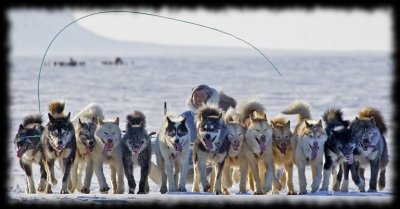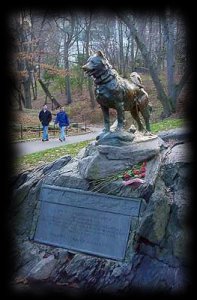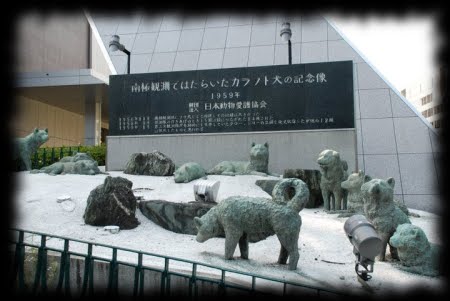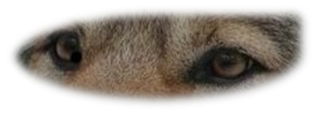Nordic Dogs
History of the Nordic Dogs

The dog was domesticated by the people - in contrast to most other pets - probably not because of its physical, but its psychological qualities. Once the person recognized certainly soon that the dog possessed abilities which made possible performances for him which could be useful to the people.
Once so the ancestors of the huskies pulled heavy weights in bitterly cold polar deserts. They resisted snowstorms and the deepest temperatures, prospered under the hardest conditions and performed magnificent. Now and then they also served as a helper with the hunt.
Today the ancestors of the Nordic hunting dog's races (one assumes that the huskies have come out from the so-called peat dog group) wandered with their owner always by the endless width of the taiga and placed, daredevil and fearlessly, bear and lynx, elk and deer after. Smaller hunting dog's races were used in Northern Europe and Siberia for the hunt on feather game. The corresponding is considered to the Japanese spitz's races. The domestication has led mainly to fur and hair deformations and hardly, as with other dog's races, for skeleton shortenings or - distortions.
The dogs made it possible for the nomads in the tundra to hold, to breed and to use hats.
The person created to itself four-legged helpers without whom he would hardly ever have done the arctic regions his living place. The Nordic dogs were stamped by this work and their living space profoundly.
Their modesty, their physical hardness and resistance are legendary and search in vain for their equals. They are fulfilled by eagerness for work and the pressure to run, to wander in the width, to move.
Their cheerful roguishness and perpetual philanthrophy makes them in general bad guards. On the contrary their awake interest in the events in their environment stamps them to fast hunters. Some races distinguish themselves by a distinct hunting passion which they have taken over, how the herd qualities, from the relationship with the wolf. Drill, obstinacy and constraint do not lead with them to the aim. Detailled and varied work, even if it is tiring, seems to them meaningful, specially if they have to solve an essential part of the task independently, without a lot of adding by the people.
The circumstance that the Nordic dog reveals an essential part of its characteristic physical and psychological qualities only and first of all by its work, is one of the reasons for the fact that the husky sport is classified always positively, because this also represents nature test as the performance appropriate to the husky races and in certain sense.
However, the Nordic dog's breeds were drawn not only in their psychological race picture by the work and their living space, also the physical qualities, also the exterior manifestation, are characterized in whole unique way by these factors.
Still we find with them different body characteristic features, which also the ancestor of the house dogs, the wolf, mark. They possess a natural, inside hairy ear, a double coat, consisting of close, fine underwool and hard, weatherproof beard hair, as well as a mobile, bushy rod, with which they cover nose and the face to warm up the breath air while sleeping.
Since centuries these four-legged companions of the people have proved themselves in the Arctic, in Northern Europe and north Asia as draught animals, hunting helpers and quardians of pensioner's herds. By the natural hierarchy which rules among these dogs, these are suitable extremely well for the sleigh-pulling.
Big performances of the Nordic dogs
Only during the last hundred years the public has learned about the big strains which are for huskies daily by researcher who had to fulfill superhuman tasks in the eternal ice. As itself in 1909 the American Robert E. Peary with five sleighs and 40 bottom plate dogs on the way did the North Pole, the world public experienced for the first time details about the considerable performances of the huskies.

Two years later the Norwegian Roald Amundsen reached the South Pole. Only he would never have reached it probably. His 116 Greenland dogs stood beside him and his team.
Amundsen later often has told how difficultly it has been to convince the dogs who had evidently no notion of their obligations, which was the necessity of the disciplined sleigh-pulling. The animals hardly stood side by side in the tableware and the command for the start was given, the dogs considered it as a demand to scuffle. It lasted hours, since the researchers had disentangled all caught leashes again. The adventurers knew, a "dog's riot" would have meant the sure death in the eternal ice.
Amundsen very much paid attention to the fact that the dogs were not educated with the whip in spite of the bad "obligation view" to the obedience. To him it was clear that no frightened animal can assert itself in the frozen waste. Amundsen spoke later to his dogs the same interest in the success of the expedition to like the men.
At this point the history about Robert Scott, the British naval officer and South Pole researcher should be mentioned. When a whole sleigh bottom plate had fallen in a crevasse, he roped 60 feet deep to save his dogs. Scott did not bring it about the heart to drive his animals thousands of kilometers through the ice fields and then allow to pitifully go to pieces in the crevasse. He knew around the mutual dependence between the people and the huskies.

In January, 1925 the world stopped the breath, when in the city of Nome in Alaska a Diphterie-epidemic had broken out and no suitable serum was available in this city buried by snow masses. Only by calls on radio broadcasting and press one succeeded in gathering a satisfiable amount of the vaccine in America. On the 12th of January, 1925 arrived from an American Public Health Office on the way skillful serum package which weighed just ten kilograms, on the railway station in Nenana. From there to Nome, however, there were neither streets nor train connections. More than 1000 kilometers had to be put back with dog's sleigh. The world participated in this race against the death in broadcast receivers. Several men and their huskies made the impossible possible. For over 1000 kilometers they needed with their dog's sleighs only 128 hours and with it had saved 127 human lives. One must make clear to himself that the post sleigh which drove the distance of Nenana to Nome regularly was on the way for approximately 3 weeks. Still today a husky running on the 1820 kilometers long distance takes place in memory of this act annually in February from Anchorage to Nome. Today this running is considered as the hardest running to the huskies and is known under the name Iditarod.

In 1957 the Japanese ventured an Antarctic expedition. 20 first-class Akita-Inus pulled the sleighs. One had selected these dogs because by the Japanese they are counted to the strongest huskies because of their solid build and their force. However, the expedition had to be broken off on account of unpredictable weather conditions. One was forced to leave behind dogs and equipment. The professional world did heavy reproaches to the researchers because they let back the dogs.
When one continued the expedition 3,5 years later, one found again in the earlier resting place 12 of these dogs living. The animals behaved so, as if there had been no many years' division. How turned out by medical examinations, the dogs had torn animals as a fodder which lived more than hundred kilometers from the resting place.
In memory of this incredible performance of the dogs a monument has been established at the instigation of the Japanese emperor Hirohito in Tokyo in the Tower. One has copied 12 life-size Akita-Inus from bronze in different attitudes.
In last decades dog's friends from the temperate regions of the earth (the USA, Canada, Europe) have begun with the controlled pure breeding of Nordic dog's races.
Today in accordance with their origin, their appearance, first of all, however, of their original function several real Nordic dog's races are distinguished, to itself in the race groups named at the top resp. FCI-sections.
The big independence and independence of these dogs does them demanding charges.
They require a lot of attention and commitment from their owner. A sporting manipulation forces itself whether of the big motor activity formally.
Nordic dogs are not suitable mostly as use dogs in the usual sense, however, can be trained with the necessary dedication and a big portion of willing on the part of the trainer.
On condition of that it is enabled for the dog to be active enough physically, the attitude can also be answered in a house. However, in general these animals are held in whole or in part outside and to several.
© Alaskan-Malamute.ch


